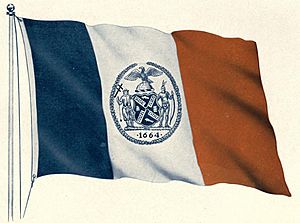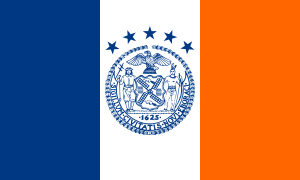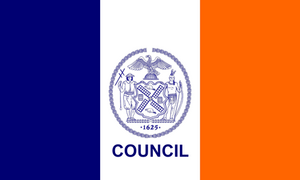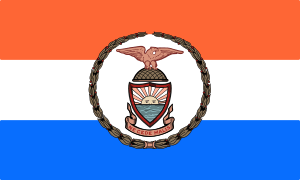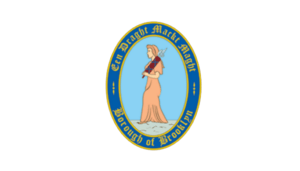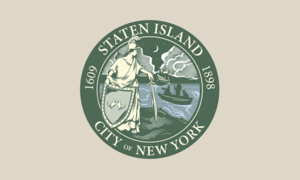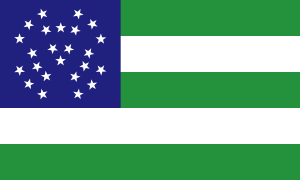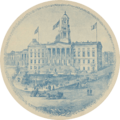Flags of New York City facts for kids
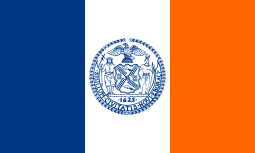 |
|
| Adopted | April 6, 1915 (modified December 30, 1977) |
|---|---|
| Design | A horizontal tri-color of blue, white, and orange with a modified blue version of the Seal of New York City in the center. |
The flags of New York City are special symbols for the city and its different parts. These include the main New York City flag, plus flags for each of its five boroughs: The Bronx, Brooklyn, Manhattan, Queens, and Staten Island. Some city departments also have their own flags. The main city flag has three vertical stripes: blue, white, and orange. In the middle white stripe, you'll see the Seal of New York City in blue. This three-color design comes from the flag of the Dutch Republic, which was used in New Amsterdam way back in 1625.
Contents
History of New York City's Flag
For many years, New York City didn't have an official flag or seal. By the late 1800s, people started using an unofficial flag. It had a blue circle (seal) on a white background.
In 1914, a special group was formed to create the city's first official flag and seal. This was to celebrate 250 years since the first mayor under English rule. The group worked with the New-York Historical Society. They looked at old seals from when the Dutch and English ruled the city. They wanted to use symbols from that history in the new flag.
The committee described their new flag like this:
In our flag, the colors are Dutch, the arms are English, the crest is distinctively American, but the flag as such is the flag of the City, which has grown from these beginnings to be the home of all nations, the great cosmopolitan city of the world, the City of New York. — Committee of the Art Commission Associates, Seal and Flag of the City of New York, p. 84
The city approved the flag on April 6, 1915. It was shown to the public for the first time on June 24.
The flag you see today was slightly changed on December 30, 1977. The date on the seal was changed from 1664 to 1625. This change was suggested by Paul O'Dwyer, who was the president of the City Council. He wanted to highlight the Dutch history of the city. The date 1625 was a bit controversial. Some thought 1624 would be more accurate, as that's when the city was officially a Dutch area. One author even joked that they picked 1625 to "beat Boston," which was settled in 1630. Even with the debate, the mayor signed the change into law.
Understanding the Flag's Design
The official design of the New York City flag is set by law. It has three vertical stripes of orange, white, and blue. The blue stripe is closest to the flagpole. The city's seal is in blue on the middle, white stripe. The law says to leave out the Latin words "Sigillum Civitatis Novi Eboraci" from the seal on the flag. The colors are the same as the flag of the United Netherlands from 1625.
What Do the Colors Mean?
The blue, white, and orange colors come from the old Dutch flag. Orange was chosen because of William of Orange, a Dutch leader. The committee explained that the darkest color (blue) is placed next to the flagpole. This is a common practice in flags like the French and Belgian ones.
The New-York Historical Society first suggested a horizontal flag. This would have been more like the old Dutch flags. However, the committee decided to keep the vertical stripes.
Symbols on the City Seal
The city seal on the flag has many important symbols:
- Bald eagle: This bird represents the United States of America.
- Native American: This figure stands for the first people who lived in the area.
- Seaman: This person represents the early settlers who came to the area.
- Beaver: This animal symbolizes the Dutch West India Company. This was the first company in New York, which was called New Amsterdam back then. The beaver is also the official animal of New York State.
- Windmill: This reminds us of the city's Dutch past. It also shows the successful business of grinding flour.
- Flour barrels: In the 1600s, New York had a special right to mill flour. This helped the new colony become a strong trading center.
- 1625: This date was added later to honor the start of New Amsterdam. However, the city was actually settled in 1624. Some historians have called the 1625 date "arbitrary" or "simply wrong."
Why is There an Inconsistency?
Even though the city law says the Latin words should be left off the flag, the city's own website sometimes shows a flag with the motto still there.
How the City Flag is Used
Sometimes, the flag is flown without the seal in the middle. This makes it a simple blue, white, and orange flag.
You can see the New York City flag flown often around the city. It's always flown at city-owned buildings, like New York City Hall. It's also seen at buildings used by city departments or schools. You'll also find it flying in city parks.
The New York City FC soccer team uses the blue, white, and orange colors of the flag. In 2017, the team even added the city flag's colors to their jersey. They replaced the seal with their own "NYC" logo.
Flags for City Leaders
Mayoral Flag
The Mayor of New York City has a special version of the flag. It has an arc of five blue stars above the seal. These stars represent each of the five boroughs. The Mayor's flag is usually 33 inches by 44 inches in size.
City Council Flag
The New York City Council also uses a different version of the city flag. It has the word "COUNCIL" written below the seal.
Flags of the Boroughs
Currently, only Brooklyn and the Bronx have official borough flags. The other three boroughs use flags that are not officially adopted. Staten Island tried to get its flag officially recognized but was not successful.
The Bronx Flag
The flag of the Bronx has three horizontal stripes: orange on top, white in the middle, and blue on the bottom. These colors are like the old Dutch flag. In the center, there's a laurel wreath, which means honor and fame. Inside the wreath is the Bronck family coat of arms. This shield shows the sun rising from the sea, symbolizing peace, freedom, and trade. Above the shield is an eagle facing east with its wings spread. This represents "the hope of the New World while not forgetting the Old." Below the shield, the borough's motto reads "ne cede malis." This Latin phrase means "Yield not to evil."
The Bronx flag was first suggested in March 1912.
Brooklyn Flag
The flag of Brooklyn has a white background with a seal in the center. Inside the seal, there's a young woman in a robe on a light blue background. She holds fasces, which is a symbol of unity. Around this image, a dark blue ring has the old Dutch phrase "Een Draght Maekt Maght." This means "Unity makes strength" in English. The words "Borough of Brooklyn" are also in this ring. The seal's edges are gold-colored. The main colors of the seal, blue and gold, are the recognized colors of the borough.
Manhattan Flag
The official flag of the Borough of Manhattan looks very much like the New York City flag. The only difference is that it uses the seal of the Borough instead of the City Seal. The Manhattan seal is round, similar to the city's, but it has two stars below it. It is surrounded by the words "BOROUGH OF MANHATTAN" and "NOVEMBER 1, 1683." This date is when New York was divided into twelve counties, and New York County (Manhattan) was created with its current borders.
Queens Flag
The flag of Queens has three horizontal stripes. The top and bottom stripes are sky blue, and the middle one is white. These colors come from the coat of arms of the first Dutch Governor, Willem Kieft. In the center, there's a design with a ring of wampum, a tulip, and a rose. In the top-left corner, there's a crown, the words 'Qveens Borovgh' in gold, and the year 1898. This was the year the five boroughs joined together.
The symbols on the flag tell the borough's history. The wampum honors the Lenape native people. They called the land 'Seawanhaka,' meaning "island of sea shells," because they collected shells there to make beads. The tulip represents the Dutch, who were early settlers. The red and white rose is a Tudor rose, a symbol of England and its monarchy. The queen's crown shows that the borough was named after Catherine of Braganza, who was Queen of England in 1683.
The Queens flag was adopted on June 3, 1913. It was first shown four days later during a celebration for the start of the borough's subway system.
Staten Island Flag
The flag of Staten Island was adopted in 2002. It uses ideas from a contest held in 1971. This contest was organized by Staten Island's Borough President, Robert T. Connor. The flag has flown over local newspaper and business buildings. It is also displayed in City Hall and Staten Island Borough Hall. The flag has a white background with an oval in the center. Inside the oval, there's a blue sky and two white seagulls. A green outline shows the countryside, and a white shape represents the city, showing residential areas. In the middle of the oval, the words "Staten Island" are in gold. Below the name, five wavy blue lines symbolize the water around the island.
The previous Staten Island flag was navy blue with an orange seal. It had two waterfowl and the text "Richmond Borough 1663 1898 S New York." This flag reflected its old name, "Richmond."
The current Staten Island flag has been criticized by Borough President James Oddo. He said it "looks like a garbage pile."
In March 2016, Oddo wanted to replace the flag's center emblem with the borough's seal. This seal shows a female figure standing on the borough. She looks out at the Narrows, where Henry Hudson's ship "The Half Moon" sails.
Flags of City Departments
Police Department Flag
The flag of the New York City Police Department was adopted in 1919.
It has twenty-four stars on a blue background. These stars represent the original towns and villages that now make up the city. Five green and white stripes stand for the five boroughs.
When police officers are killed while on duty, the police department flag is draped over their caskets.
Fire Department Flag
The flag of the Fire Department of the City of New York has five red and white stripes. These stripes represent the five boroughs. The top-left corner has a Maltese cross with the city seal in the center. Around it are a hook, ladder, fire hydrant, and the letters "F.D.N.Y."
The Fire Department uses a different flag for memorial services. It is vertical, with the Maltese Cross turned on its side and gold fringe. This flag is draped over the caskets of fallen department members.
Department of Correction Flag
The flag of the Department of Correction was adopted in 1998. This was for the 100th anniversary of New York City joining together. It has sixteen blue and white stripes. This is the number of major facilities the department managed at that time. On an orange top-left corner, the Seal of the City of New York is in gold. It is surrounded by five stars for the five boroughs and the year "1895," when the department was created.
Parks and Recreation Flag
The flag of the Parks Department shows the department's leaf logo in green on a white background.
The Parks Department flag flies on a tall pole in every park in New York City. It flies alongside the city flag and below the flag of the United States of America. These tall poles were a bit controversial when they were first put up in 1997. Some people thought they were not suitable outside of a boat setting. Others felt the Parks Commissioner was going too far.
Sheriff's Office Flag
The flag of the New York City Sheriff's Office is navy blue. It has the city's seal in blue on a white oval shape, outlined in gold and red. The words "SHERIFF'S OFFICE" and "CITY OF NEW YORK" are written in gold text above and below the seal.
Sanitation Department Flag
The New York City Department of Sanitation flag is blue. It features the department's symbol, which is a caduceus with the letter "S" on it. Around this symbol, the words "THE CITY OF NEW YORK" and "DEPARTMENT OF SANITATION" are written in gold.
Images for kids
-
An 1895 picture of Brooklyn Borough Hall, showing Brooklyn's city flag.
See also
 In Spanish: Bandera de la ciudad de Nueva York para niños
In Spanish: Bandera de la ciudad de Nueva York para niños




